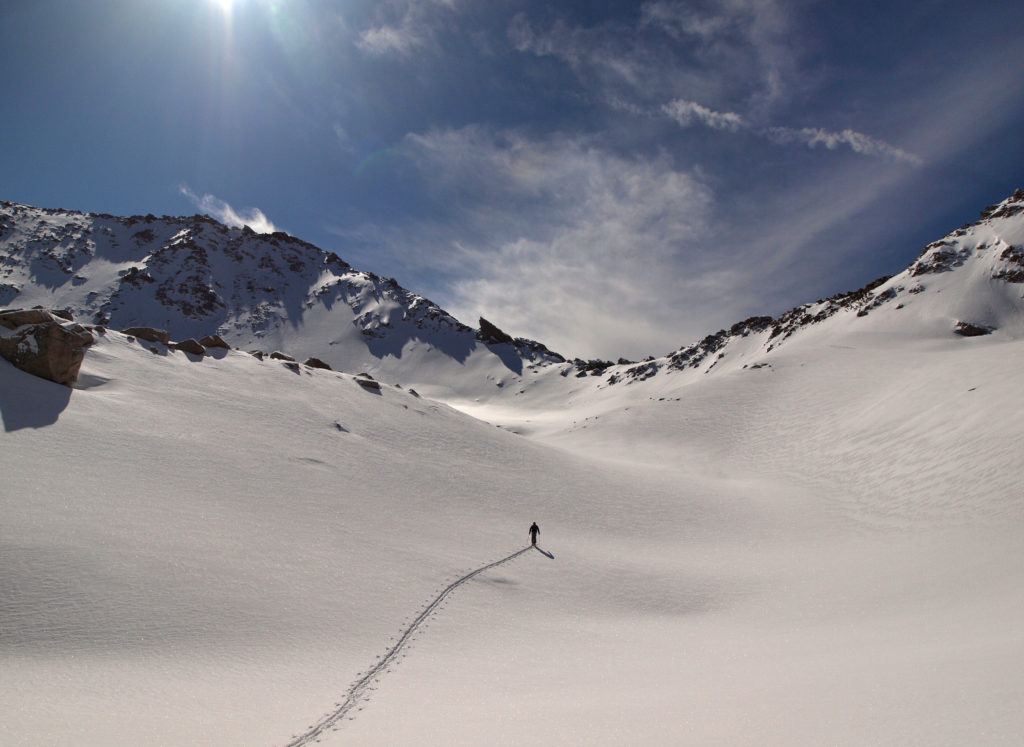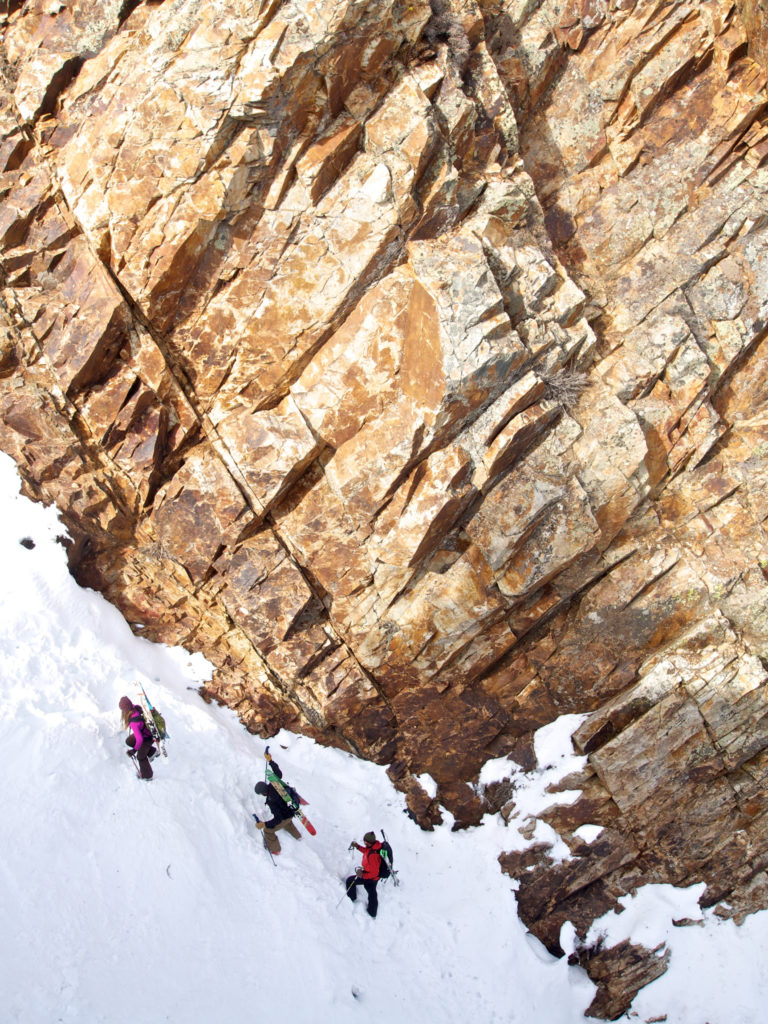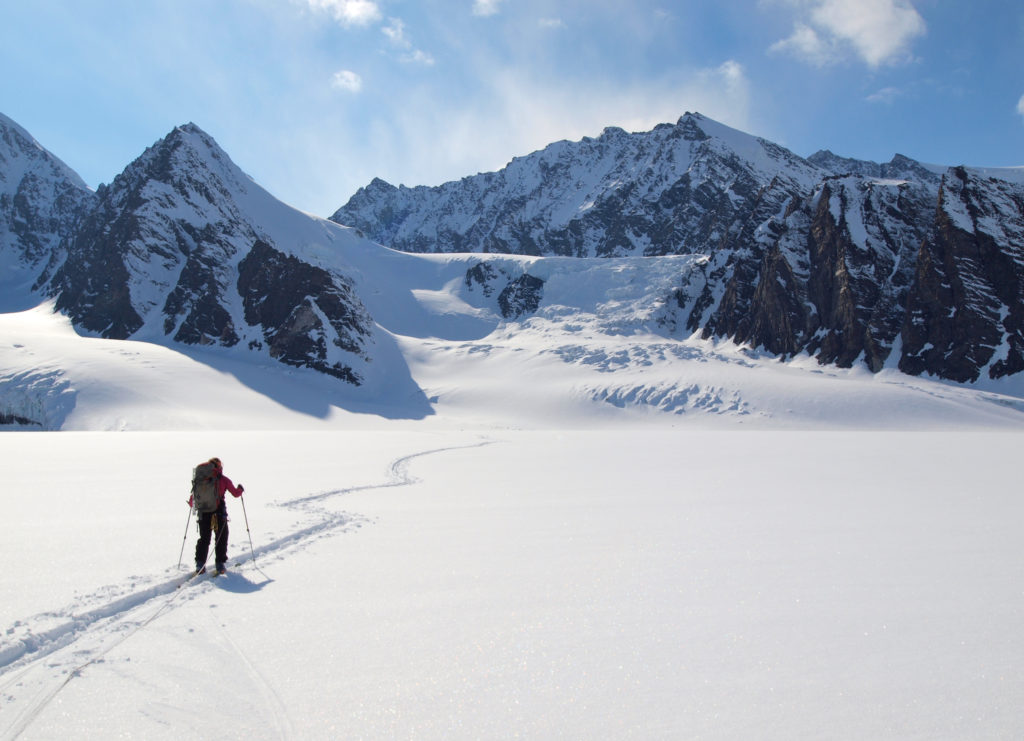Rob Young Sr. near Blair Lake in the Centennial Range, MT
Every single powder turn I’ve made in my lifetime has become a blur. As a backcountry skier, I’ve experienced my fair share of face-shots, yet each powder turn tends to blend into the next as time goes on. Powder turns are addicting, yet fleeting. What brings us back into the backcountry again and again has got to go ‘deeper’ than the turns themselves. The backcountry skiing bible of our modern era, the ’50 classics’, admits this reality from the start. “Skiing is sensory, ephemeral, and elusive.” As time passes, the images and memories we remember most vividly from our days of ‘skiing’, seem to be of everything but the ski turns.
For me, it started with a dollar. One dollar. Affectionately referred to as the ‘dollar of the day’. As a kid, blessed (and cursed) by being raised on skis, I really had no idea how much fun I was having while skiing. I had nothing in my short life to relate skiing to on a scale of ‘not fun’ to ‘fun’. It was just something we did as a skiing family under the leadership of a ski patrolling father. But that dollar, given to me every day as long as I skied until 3:00pm, was all I needed. It was my reward for the day for simply going off with my cousins and pointing our skis straight down midwest groomers, building jumps, and snaking together bobsled tracks through the dense midwest tree islands. The freedom to spend that dollar however I saw fit was empowering, until that dollar was gone, lost into the greasy coin trap of an arcade machine, or traded for a bag of jelly beans at Pearson’s General Store in the Village at the base of Boyne Mountain, MI.
The formidable teenage years arrived. Ski race practice every night after high school meant unsupervised bus rides, ski area cafeteria dinners, and lift rides with girls. I was there to ski, but just like during childhood, it really wasn’t about the skiing. In rural northern Michigan towns, skiing was a small niche, and it felt like it was important to be a part of it. It made me feel special to be the weird kid who missed out on every social event imaginable because I went skiing every night, and every weekend. It was about throwing helicopters in race skis, showing off, and simulating extreme skiing on our tiny midwest hills. It was about dreaming; pretending in our minds that we were skiing something bigger, and dreaming about moving west.
I continued on the path of what was deemed a ‘normal life’ for the traditional midwest kid into my college years, and I set out to earn a diploma, per protocol. But as I studied and played the role of a focused scholar, the calling of skiing and ski culture continued to burn in the back of my mind. “What a life it would be”, my 18-year old self thought, dreaming of one day living in Little Cottonwood Canyon and bumping chairs. The day after my graduation ceremony, my car was packed with warm clothes and my 74mm wide “all-mountain skis” and I was off, westbound on I-80 towards Utah.
For those with aspirations to ski big, wild mountains, it doesn’t take long to begin looking out beyond the controlled confines of the ski area before wanting to venture out into the natural landscapes of the backcountry. It only took a few short months for me. Following my graduation and a move west, I began piecing together work in Park City, building moguls and skier-X courses for grocery and beer money. After a few months confined to the ‘packed powder’ mogul fields and gentrified comforts of a modern ski area, the urge to ski the natural landscape, or the ‘blank slate’, was too great. My first backcountry telemark skis and skins were purchased that spring. I coaxed my neighbor, Rob, to pick up a setup as well, and jump into the world of backcountry skiing head first. Over the course of that spring, skinning uphill slowly morphed from a blurry, sweaty, sufferfest, into a tolerable means to access good spring corn skiing. The reward soon became worth the work.
‘What the hell is a facet’, I wondered. That following winter, the avalanche forecast became my textbook. I would read it every morning that first winter of ski touring. Every morning, whatever lingo I read in that forecast, I made sure I understood. I knew enough to know that I didn’t know much, and during those early winters of backcountry skiing, the layered natural snowpack became my teacher. Digging holes, learning how to safely move through the mountains, and trying my damnedest to not get myself killed. Before I knew it, what was once simply a tool to ski untracked powder, eventually birthed a fascination with the science of snow.
Ski touring was not such a popular sport in Steamboat, where I had relocated to work a geology job. Most backcountry skiers relied on snowmobiles for access, confining the majority of backcountry skiers to a couple compact regions of the Park Range accessible by machine. With no money for a sled and unlimited determination, the steep treed canyons of the Park Range, most of which are inaccessible by snowmobile, became our playground, including ‘The North Fork of Soda Creek’. We spent a few winters crossing only our own ski tracks as we explored the steep tree skiing, tight chutes, and pillow lines of this private canyon. Superb skiing aside, it was even more fascinating to make this canyon our own. I made maps of the shots we skied, naming them after our inside jokes, often referencing life events that occupied our lives outside of this utopic drainage. ‘Viva Peru’, ‘Stuffed Crust Pizza’, ‘Snot Rocket’, to name a few. Seven years later, I don’t remember a single ski turn in the North Fork, but I do remember laughing hysterically while brainstorming names on the skin track, finding bear tracks in the spring, learning to dig a snow cave, cook extravagantly with a Jetboil, and experiencing my first nights sleeping outside in the winter.
Geology work took me all over the country in subsequent years, and coming home to Colorado, and then Utah, became my time to reset. Ski touring became much more about the connection I had with my home than about the turns. I enjoyed climbing the mountains as much as I enjoyed skiing them. I began to obsess over moving uphill. I eventually left that geology job, citing an imbalance between work and mountains. Thereafter, even when guiding or ski patrolling for work, I felt the need to spend every day off perfecting my craft; setting the perfect skin track. To ‘go skiing’ was an excuse to move far and fast through the alpine. And to set the perfect skin track meant creating one that maintains a pitch that rarely deviates, and one so efficient it lends less to the the bruteness of the climb, and more to a wandering mind. It also became an entertaining challenge to set a skin track where a skin track didn’t seem possible; a 5th-class skin track as they affectionately became known. Setting a skin track became my art, a perfect blend of my own human interaction with the natural winter landscape.
Through my ‘adult’ years of ski touring, photographs from days out have gradually transitioned away from ‘hero’ powder shots, and consist mostly of friends breaking trail. The slow motion nature of trail-breaking lends itself to vanishing lines, perspective, and topography in photographs. Ski movies and magazines have only rarely celebrated images of uphill travel (long live Powderwhore!), and they surely aren’t often featured as the cover shot of a magazine. But just like setting a skin track, photographing one is similarly a craft, something that can never be fully mastered.
As the years have blended together, so have all the ski tours. My ski partners have become fewer in number, yet stronger in friendship. Skiing the steep and wild, or meadow skipping on unstable early season snowpacks, we’ve seen it all together. We’ve created ski touring traditions together. We’ve changed unhealthy traditions into healthy ones, and back again. Copenhagen and cigarettes. Twizzlers and Cheez-Its. The Wednesday Special at the Wing Coop in Salt Lake. Never asking Scotty to drive his beat-up Honda Accord up the Canyons. Pumping Nat full of sugar. Big ski trips every spring. These traditions are what keep us coming back to the same places, keep us skiing even during the high and dry mid winter thaws, and help sear worthy moments and images of ski touring into our memories. Summits. Sunrises. The smell of a muddy trailhead parking lot in springtime. A perfect skin track. Leftovers. Tents. Sunburns and Sunsets. Hitchhiking. Whoomphing. Waterlogged gloves. And everything else in between. Horrible snow or bottomless pow, tired legs in tow, ‘everything else’ about skiing makes it worth getting out, every time.

















